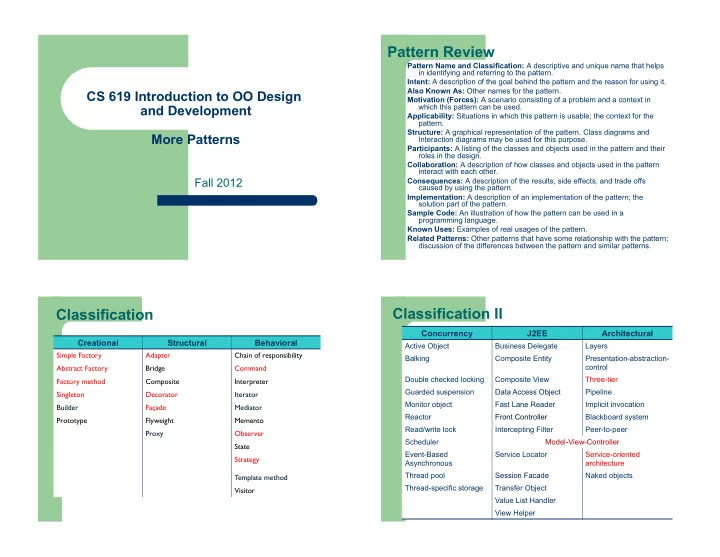

Pattern Review Pattern Name and Classification: A descriptive and unique name that helps in identifying and referring to the pattern. Intent: A description of the goal behind the pattern and the reason for using it. Also Known As: Other names for the pattern. CS 619 Introduction to OO Design Motivation (Forces): A scenario consisting of a problem and a context in and Development which this pattern can be used. Applicability: Situations in which this pattern is usable; the context for the pattern. Structure: A graphical representation of the pattern. Class diagrams and More Patterns Interaction diagrams may be used for this purpose. Participants: A listing of the classes and objects used in the pattern and their roles in the design. Collaboration: A description of how classes and objects used in the pattern interact with each other. Fall 2012 Consequences: A description of the results, side effects, and trade offs caused by using the pattern. Implementation: A description of an implementation of the pattern; the solution part of the pattern. Sample Code: An illustration of how the pattern can be used in a programming language. Known Uses: Examples of real usages of the pattern. Related Patterns: Other patterns that have some relationship with the pattern; discussion of the differences between the pattern and similar patterns. Classification II Classification Concurrency J2EE Architectural Creational Structural Behavioral Active Object Business Delegate Layers Adapter Chain of responsibility Simple Factory ! Balking Composite Entity Presentation-abstraction- control Abstract Factory Bridge Command Double checked locking Composite View Three-tier Factory method Composite Interpreter Guarded suspension Data Access Object Pipeline Singleton Decorator Iterator Monitor object Fast Lane Reader Implicit invocation Builder Façade Mediator Reactor Front Controller Blackboard system Prototype Flyweight Memento Read/write lock Intercepting Filter Peer-to-peer Proxy Observer Scheduler Model-View-Controller State Event-Based Service Locator Service-oriented Strategy Asynchronous architecture Thread pool Session Facade Naked objects Template method Thread-specific storage Transfer Object Visitor Value List Handler View Helper
Three Modules of MVC Three Modules of MVC ! The MVC pattern cleanly separates the modeling of the domain, the presentation, and the actions based on user input into three separate models – Model ! The core of the application. This maintains the state and data that the application represents. When significant changes occur in the model, it updates all of its views. – View ! The UI which displays information about the model to the user. Any object that needs information about the model needs to be a registered view with the model. – Controller ! The UI presented to the user to manipulate the application. MVC Advantages ! Clarity of design ! Efficient modularity ! Multiple views ! Ease of growth ! Distributable ! Powerful user interfaces
N tier Architecture 3 tier Architecture ! Presentation Layer : the layer responsible for displaying user interface. ! The n tier architecture is based on the concept ! Business Tier : the layer responsible for accessing the of separating a system to different layers data tier to retrieve, modify and delete data to and from (usually 3) the data tier and send the results to the presentation tier. ! Each layer interacts with only the layer directly BLL and DAL below, and has specific function that it is Often this layer is divided into two sub layers: the responsible for. Business Logic Layer (BLL), and the Data Access Layers (DAL). Business Logic Layers are above Data Access Layers, meaning BLL uses DAL classes and objects. DAL ! Classic for IT systems is responsible for accessing data and forwarding it to BLL. ! Data Tier Data tier is the database or the source of the data itself. Service Oriented Architecture (SOA) SOA - Principles ! SOA is an architectural style whose goal is to ! Visibility – the ability for a service consumer achieve loose coupling among interacting to � see � a service provider (Awareness, software agents. willingness and Reachability) ! A service is a unit of work done by a service ! Interaction - the activity of using a capability. provider to achieve desired end results for a (usually message exchange - by contracts, service consumer constraints and policies, for example Web Service Description Language) ! in SOA, services are the mechanism by which needs and capabilities are brought ! Effect – the result of an interaction together.
SOA - example
Recommend
More recommend